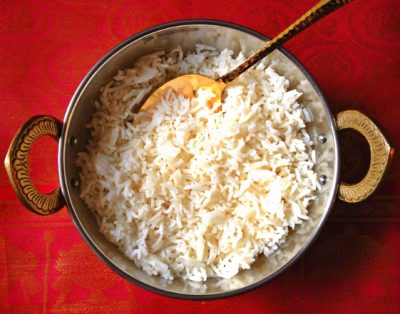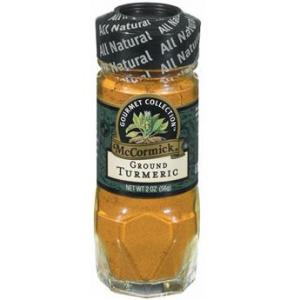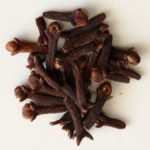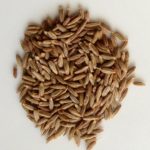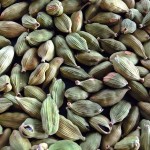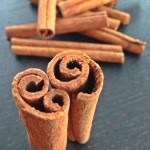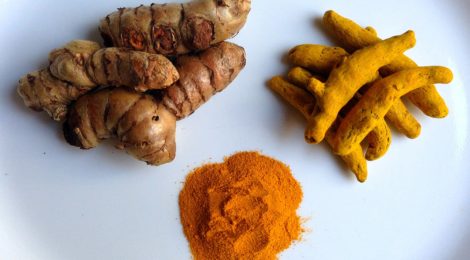
SPICE SPOTLIGHT: TURMERIC

Turmeric is available in three forms: fresh turmeric root (top left), dried turmeric root (top right) and ground turmeric powder (bottom).
What is turmeric?
Turmeric is the root of the turmeric plant, Curcuma longa, which is a member of the ginger family. As pictured above, turmeric is available in three forms: fresh turmeric root, dried turmeric root and ground turmeric powder. Turmeric is used in South and East Asian cooking, to naturally color commercial food products like American mustard, and in South Asian religious rituals. (In fact, when I married my husband Sean we had a “turmeric crunching” ceremony called harshna kuttuvudu, otherwise known as “making of the bride”.) While turmeric is available in all forms, it is ground turmeric powder that is most common. To make ground turmeric, the fresh turmeric root is boiled in water for several hours and then dried in a hot oven. The resulting dried turmeric root is then ground into turmeric powder — a process that is very difficult given the rock-hard, concrete-like state of dried turmeric root. India and Pakistan are major producers of turmeric, where it is also known as “poor man’s saffron” or “Indian saffron”. For thousands of years, turmeric has been used as a part of Ayurvedic medicine.
What does turmeric look like?
Ground turmeric is well known for its deep, bold yellow color that is often described as “golden”. “The Spice Bible” describes turmeric as “nature’s most vibrantly colored spice”. Turmeric has an ability to stain and dye, which is why it is often used as a natural food colorant. Fresh turmeric root is more orange than yellow, similar to that of carrots. When pulled from the ground, fresh turmeric looks similar to fresh ginger in terms of shape and form. After it has dried, it becomes smaller as a result of the amount of moisture lost during the drying process.
What does turmeric taste like?
Turmeric has a bitter, earthy, musty flavor that is most intense in its dried and ground forms. Fresh turmeric is more palatable when consumed straight — it has the sharp, earthiness of ground turmeric with a pungent, refreshing finish and after-taste similar to that of fresh ginger. In Indian food specifically, ground turmeric adds an astringent taste to curries. If you’re interested in how different spices flavor an Indian dish, read more on the 6 Key Elements of Taste in Indian Cuisine.
What are the nutritional benefits of turmeric?
An active ingredient of turmeric is curcumin, which has been shown to exhibit antioxidant, anti-inflammatory, antiviral, antibacterial, antifungal, and anticancer activities. Thanks to its anti-inflammatory action, curcumin has a potential healing effect on chronic diseases such as diabetes, allergies, and arthritis. Curcumin makes up about 5% of the turmeric spice. As a result, its antioxidant effect provides powerful protection against the cellular damage that causes and/or accelerates many chronic diseases.
How can I use turmeric in cooking?
Turmeric is one of the key ground spices you need for basic Indian cooking. Along with other ground spices like coriander and cumin, ground turmeric is used when cooking curry dishes. Because ground turmeric has a strong, bitter taste, it is important to not use more than required when adding it to a dish. Fresh turmeric can be grated or chopped and added to salads, smoothies and root vegetable slaws. Given turmeric’s ability to stain and dye, it is important to handle it carefully when cooking — especially fresh turmeric root (gloves are often recommended).
Which Big Apple Curry recipes feature turmeric?
Turmeric can be used in cooking the following authentic Indian dishes:
Chick Peas Curry (Channa Masala)
Okra with Onions
Salad with Curried Black Eyed Peas
The 5-10-5 Rule
To make a variety of authentic Indian dishes at home, you need a few key things in your pantry and fridge. In the course of teaching my husband Sean the basics of Indian cooking, I created The 5-10-5 Rule – a useful cheat sheet on the main aromatics, ground spices, whole spices, and herbs you need in your kitchen.

10 key ground spices for Indian cooking — starting from top left to right: cumin, coriander, sugar, curry powder, paprika, salt/pepper, garam masala, TURMERIC, and red chilli flakes
